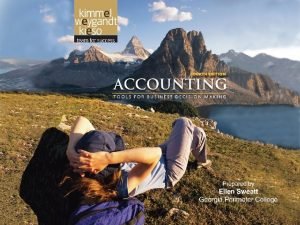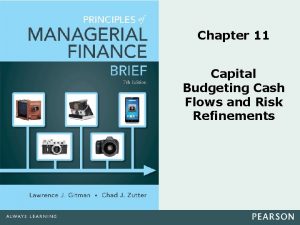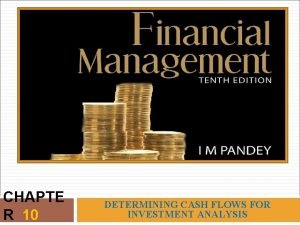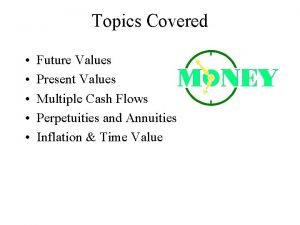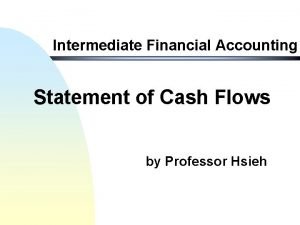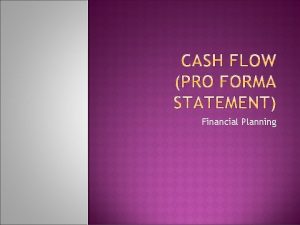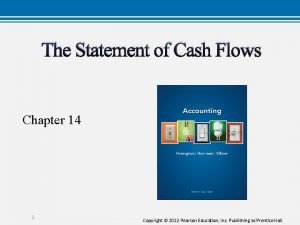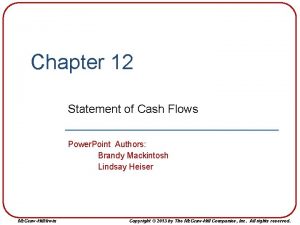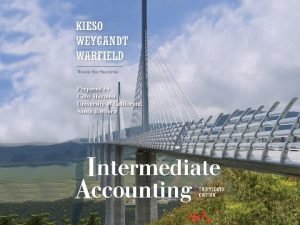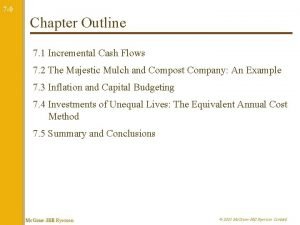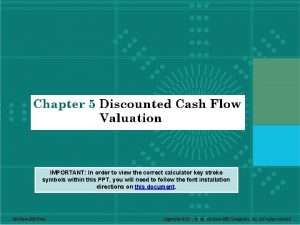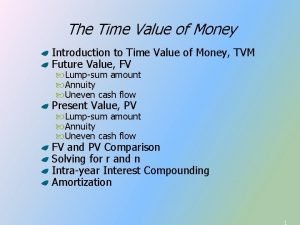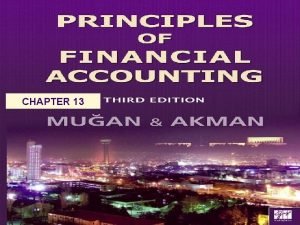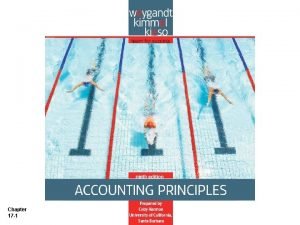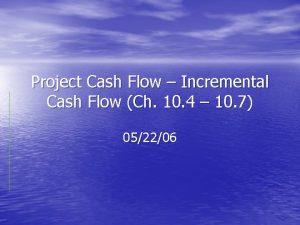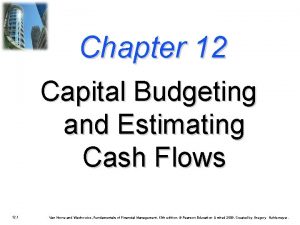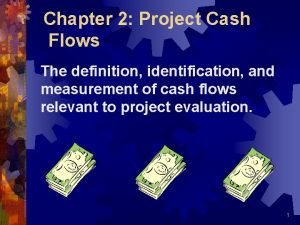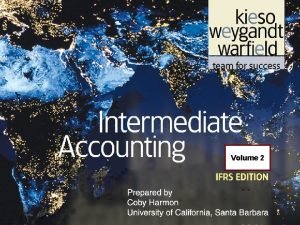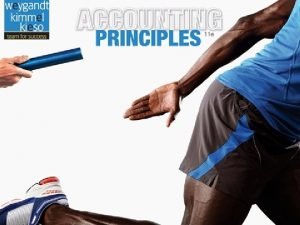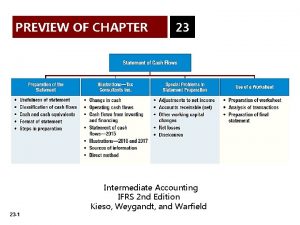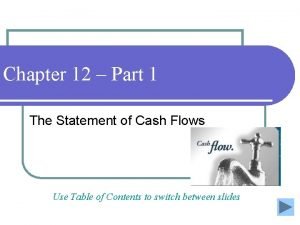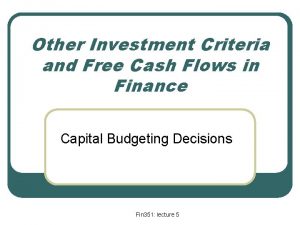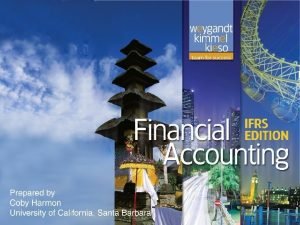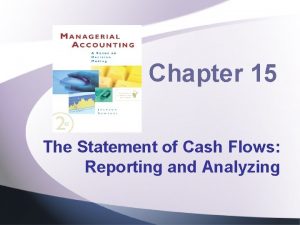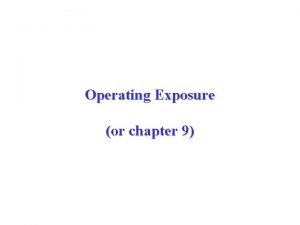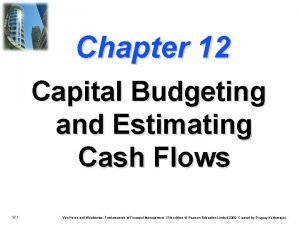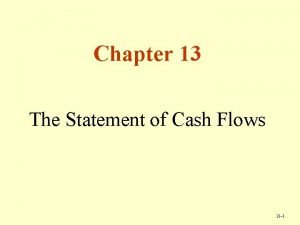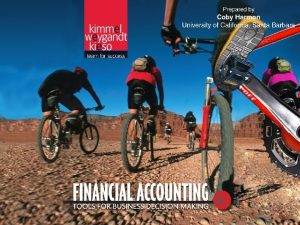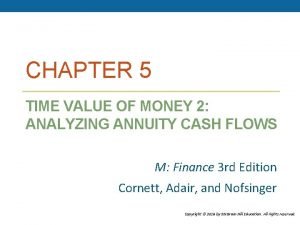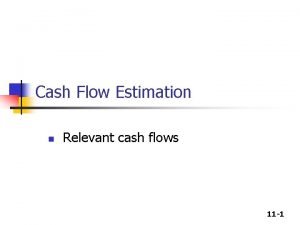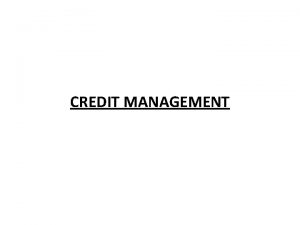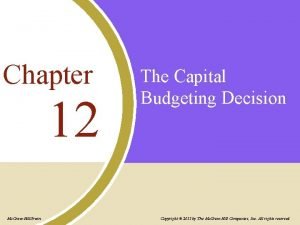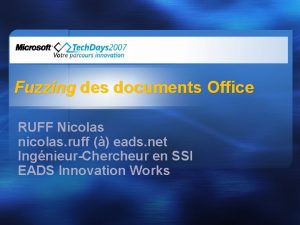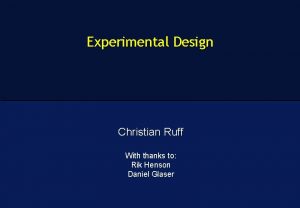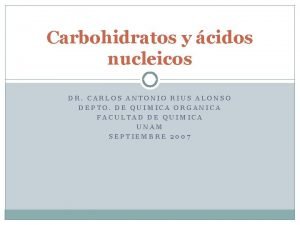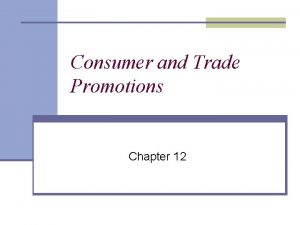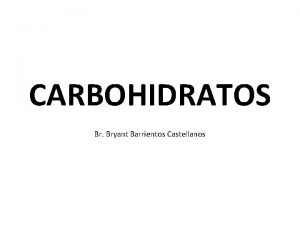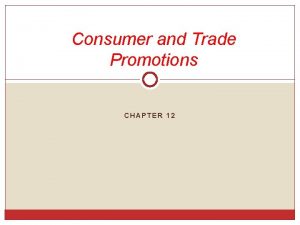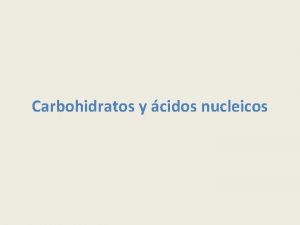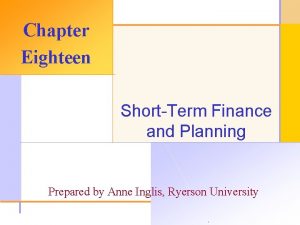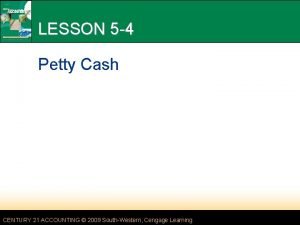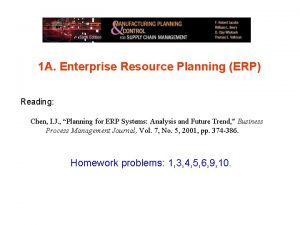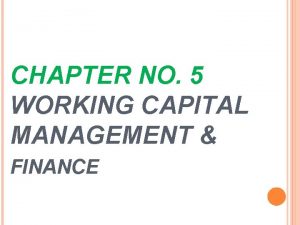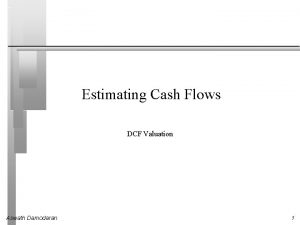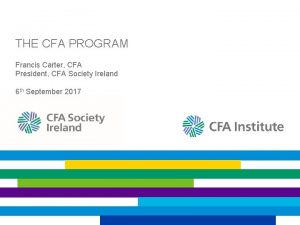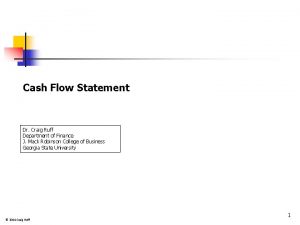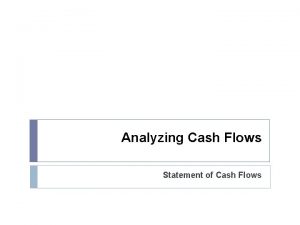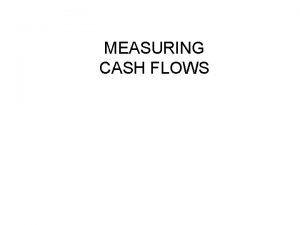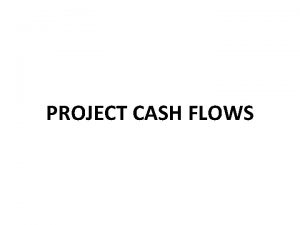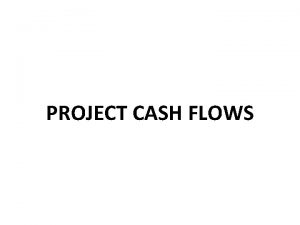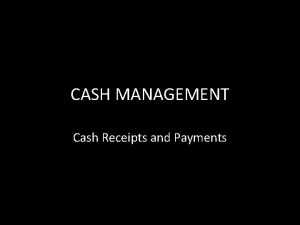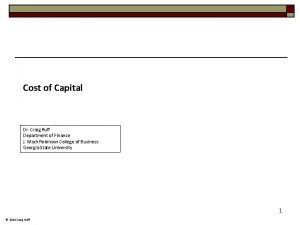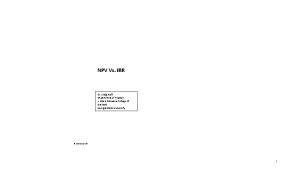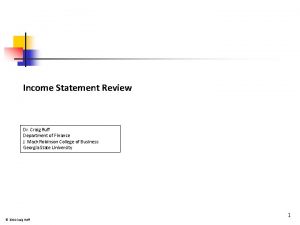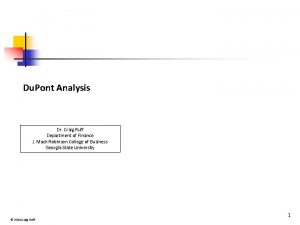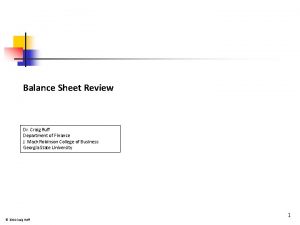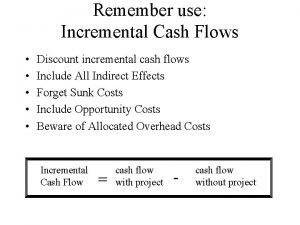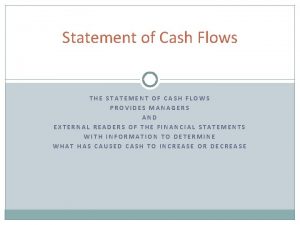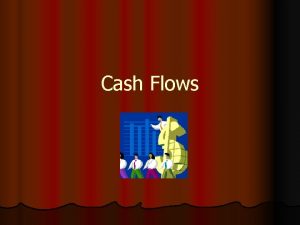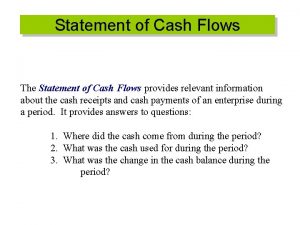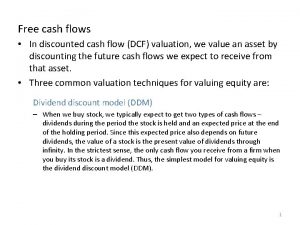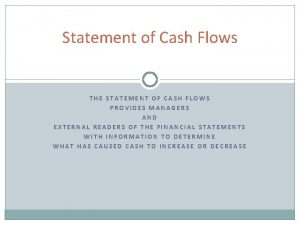Cash Flows Craig Ruff Ph D CFA Capital



















































- Slides: 51

Cash Flows Craig Ruff, Ph. D. , CFA

Capital Budgeting Layout Decision Capital Budgeting Model Weighted Average Cost of Capital Appropriate Cash Flows

Cash Flows Capital Budgeting Layout Models Payback Period NPV IRR Now, we will cover the inputs to the models – the cash flows

It is about more than just numbers…. Incremental Cash Flows: the Core Ideas… “The study of economics won't keep you out of the breadline; but at least you will know why you are there. ” attributed to Frank Knight (1885 -1972); Knight was an economics professor at the University of Chicago from 1927 until 1955 and one of the founders of ‘Chicago School’ of economics "People do stupid things" Vonage People do irrational things

Incremental Cash Flows: the Core Ideas… 1) Focus on cash flows (and not accrual income numbers) 2) Focus on incremental cash flows 3) Sunk costs are sunk 4) Opportunity costs – a piece of already owned land is not “free” as it could otherwise be sold 5) Think of the whole company (such as, cannibalized sales of existing operations are not really incremental sales)

Cash Flows… First, let’s consider the focus on incremental cash flows (and not the accrual income numbers). We will do this by way of an example.

Cash Flows… Three Buckets Woodard Boats, Inc. is considering beginning production of a new model of ski boat at its Owingsville, KY plant. The expansion will require the immediate purchase of machinery costing $32, 000. Sales from this project are expected to be $17, 500, 000 per year. The operating expenses (excluding depreciation) are expected to equal $11, 300, 000 per year ($6. 3 m in COGS and $5 m in operating expenses). The company uses straight-line depreciation. The project has an economic life of 15 years and the machinery has a salvage value of $2, 000, and will sold for that amount at the conclusion of the project. Woodard’s marginal tax rate is 40%.

Three Buckets The three buckets… Initial Cash Flow Operating Cash Flows Terminal Cash Flow

Cash Flows… Three Buckets Initial Cash Flow -$32, 000 The first thing we will put in our buckets is the initial outlay of $32, 000 to purchase the machinery.

Cash Flows… Terminal Cash Flow $2, 000 in 15 th year We can also capture the positive cash flow to the firm when the company sells the machinery at the end of the project (typically for the salvage value).

Three Buckets Operating Cash Flows Next, we will tackle the operating cash flows. The easy way to do this is to start with a simple income statement.

Cash Flows… Three Buckets To calculate the operating cash flows (OCF), start with a basic income statement. Depending on how the problem is set up, you may or may not need to break out the cost of goods sold from other expenses.

Cash Flows… Three Buckets Going back to the example, we can put numbers into this basic income statement. As a quick note, we are always using true marginal numbers associated with the project.

Cash Flows… Three Buckets Here, we are using basic straight-line depreciation.

Cash Flows… Three Buckets In estimating the operating cash flows, we ignore interest expense. Interest expense will be part of the cost of capital (WACC), which we will eventually use to discount the cash flows in the NPV calculations (or as a hurdle rate in IRR). Thus, including interest expense here and also in the WACC would be double counting.

Cash Flows… Three Buckets Note: Because interest expense is tax deductible, the weighted average cost of capital (WACC) calculation uses the after-tax cost of debt.

Cash Flows… Three Buckets Since we have left-out interest expense, this is not really net income. Instead, we will refer to it as net operating income after taxes (NOPAT).

Cash Flows… Three Buckets But we are not done yet. The key point is that we want the marginal cash flow associated with the project. Clearly, there is a very big adjustment we need to make to NOPAT.

Cash Flows… Three Buckets Consider the $32 m cost of the machinery. Using straight-line depreciation, the accountant would calculate the annual depreciation expense as $2 m per year. Indeed, it makes sense for an accountant to allocate the cost of the new machinery over time via depreciation. This approach better matches the cost of the machinery to the sales generated by the machine. It generates a better picture of the firm’s true profitability. From a capital budgeting perspective, though, the entire $32 m will be ‘charged’ to the very start of the project since the entire $32 m cost of the machinery has to be funded at that point…

Cash Flows… Three Buckets The point is that we have already factored in the $32, 000 cost of the machine in the first bucket (in the initial outlay).

Cash Flows… Three Buckets So, we will unwind the depreciation expense by adding it back to the NOPAT to get the operating cash flow (OCF) for the period. Please keep in mind that we have already accounted for the $32 m cost of the machine in the “initial cash flows” bucket.

Cash Flows… Three Buckets It may seem odd that we subtract depreciation when we calculate the NOPAT and then add it back on at the end when we calculate the operating cash flow (OCF) for the period. We first subtract the depreciation to reflect that even though it is a non-cash flow, it does reduce the company’s taxable income. A lower taxable income will lead to a lower tax bill, and those tax savings are real cash.

Cash Flows… Three Buckets It is really not that bad to find the operating cash flow. In essence, you will start with a basic income statement (or, a slightly modified one), skip the interest expense, and add back depreciation at the end.

Cash Flows… Three Buckets The three buckets… Operating Cash Flows $4, 520, 000 each year for 14 years So, we have the operating cash flows for this project. Please note that this is a fairly straightforward problem that has the operating cash flows equal for each year.

Cash Flows… Three Buckets The three buckets… Operating Cash Flows Terminal Cash Flow $4, 520, 000 each year for 14 years $4, 520, 000 + $2, 000 in 15 th year A big thing to remember is that the operating cash flows also applies to the final year’s cash flow (the terminal cash flow). So, in this problem, we need to also put the $4, 520, 000 in the last bucket.

Cash Flows… Three Buckets The three buckets… Initial Cash Flow Operating Cash Flows Terminal Cash Flow -$32, 000 $4, 520, 000 each year for 14 years $4, 520, 000 + $2, 000 in 15 th year All together, we our buckets look like this.

Cash Flows… Three Buckets Operating Cash Flow (OCF) The three buckets… Initial Cash Flow Operating Cash Flows Terminal Cash Flow -$32, 000 $4, 250, 000 each year for 14 years $4, 250, 000 + $2, 000 in 15 th year We want the all-in (“gross) cost (include shipping, etc. ) of the machinery. Account for salvage value and associated tax effects.

Cash Flows… Three Buckets Depending on the problem, there may be other marginal cash flows that we need to account for. http: //www. quickanddirtytips. com/education/grammar/ending-asentence-with-a-preposition

Cash Flows… Three Buckets For instance, as Woodard Boats takes on the new machinery, the balance sheet will presumably expand. (Here, I am assuming that the new machinery was financed with new debt or equity. ) Balance Sheet New Machinery New Debt or Equity

Cash Flows… Three Buckets As sales expand, other assets and liabilities will naturally increase… Balance Sheet New Factory New Debt or Equity Addition Inventory Additional Accts. Rec Additional Accounts Payable

Cash Flows… Three Buckets Change in Net Operating Working Capital: ΔCurrent Minus Operating Assets ΔCurrent Operating Liabilities Suppose with the added machinery, accounts receivables goes up $1, 500, 000, inventory goes up $1, 500, 000 and accounts payable goes up $2, 000. Granted, it is a bit of a stretch but assume this happens at the start of the project. Then, the AR Inv Minus AP Net change in net operating working capital is: +$1, 500, 000 The increases in AR and inventory use $3, 000 +$1, 500, 000 in cash. But the increase in AP is a source of $2, 000 in cash. So, the company needs to fund +$2, 000 the net $1, 000 in cash used at t=0. +$1, 000

Cash Flows… Three Buckets So, because of the project, the Woodward Boats will need additional net working capital of $1, 000, which can be liquidated at the end of 15 years. This is a fairly standard assumption in these types of problems. The idea is that the cash used at the beginning of this project will likely be reclaimed at the end of the project as remaining inventories are sold, remaining accounts receivables are collected, and accounts payable paid off.

Cash Flows… Three Buckets Initial Cash Flow Terminal Cash Flow -$1, 000 +$1, 000 In this problem, we would put a $1, 000 outflow in the first bucket and a $1, 000 inflow into the last bucket.

Cash Flows… Three Buckets Initial Cash Flow Terminal Cash Flow -$1, 000 +$1, 000 At first glance, it may seem that since we are just adding and subtracting the $1, 000, the net effect is zero. This is where the time value of money comes into play. A million dollars today is not the same as $1, 000 in fifteen years. In this case, the company had to pay the cost of funding that $1, 000 for the 15 years. Or, imagine that instead of investing that $1, 000 in working capital, the company could have invested the $1, 000 in a safe investment. Presumably, they would have well more than $1, 000 in fifteen years.

Cash Flows… Three Buckets Initial Cash Flow Operating Cash Flows Terminal Cash Flow -$32, 000 -$1, 000 -33, 000 $4, 520, 000 each year for 14 years $4, 520, 000 + $2, 000 +$1, 000 $7, 520, 000 Now, we have the cash flows that we would input into our calculators to find the NPV or IRR, or use to calculate the payback period.

Cash Flows… Three Buckets Or, we can list the cash flows in this way. Period Cash Flow 0 1 2 3 4 5 6 7 8 9 10 11 12 13 14 15 -$33, 000 $4, 520, 000 $4, 520, 000 $4, 520, 000 $4, 520, 000 $7, 520, 000 Initial Cash Flow Operating Cash Flows Terminal Cash Flow

In capital budgeting, we are only concerned with the true marginal (additional or new) cash flows associated with the project. A classic example of this is how we treat sunk costs… 37

Sunk Costs This is a classic example from economics… You live in New York City. A friend gives you two tickets to Phantom of the Opera. (Orchestra seats selling at $238. 00/piece. ) But….

Sunk Costs This is a classic example from economics… You live in New York City. A friend gives you two tickets to the Phantom of the Opera. (Orchestra seats selling at $238. 00/piece. ) But you are not feeling good and you have a big presentation to make the next day at work; thus, you decide to stay home and skip the show. * * You have no way to give away or sell the tickets. You just moved into a new house in the NYC suburbs and do not know any of your neighbors. Your internet is not connected and you have lost all of your cell phones. And you do not have time to get downtown to try and re-sell the tickets to a scalper.

Sunk Costs You do a quick analysis in your head of going versus not going. And you decide not to go. It is no big deal; you are better off not going. Go Don't Go Ticket Cost $0 $0 Happiness Low Medium Net: Low Medium Happiness

Sunk Costs Now, let’s change one assumption. Instead of the friend giving you two tickets to the Phantom of the Opera. (Orchestra seats selling at $238. 00/piece), you bought those tickets yourself. * Often, people will now decide that they are going, despite not feeling good and having a big presentation to make at work the next day. * Paying for the tickets (as opposed to having them given to you) changes the calculus of the decision. But should it? * Remember that you have no way to give away or sell the tickets.

Sunk Costs Wouldn’t you still rather be out $476 and have medium happiness than out $476 dollars and low happiness? The point is that, at the time we are making this decision, the $476 is gone either way and should not affect our decision on the margin. The $476 is a sunk cost. Go Don't Go Ticket Cost -$476 Happiness Low Medium Net: -$476 + Low Medium Happiness

Sunk Costs Sunk Cost: an expenditure that has already occurred and is not affected by the current decision…. A company is considering launching a new product The company will spend $10, 000 on a feasibility study of the new product The company makes the final decision on launching the new product

Sunk Costs Sunk Cost: an expenditure that has already occurred and is not affected by the current decision…. A company is considering launching a new product If we are here, the $10, 000 is relevant to our marginal decision. The company will spend $10, 000 on a feasibility study of the new product The company makes the final on launching the new product If we are here, the $10, 000 is irrelevant to our marginal decision.

Sunk Costs Sunk Cost: an expenditure that has already occurred and is not affected by the current decision…. A company is considering launching a new product If we are here, the $10, 000 is relevant to our marginal decision. The company will spend $10, 000 on a feasibility study of the new product The company makes the final on launching the new product If we are here, the $10, 000 is irrelevant to our marginal decision. “It’s sunk. Get over it. ”

Sunk Costs So, when we encounter a sunk cost… we ignore it.

Opportunity costs… You buy a piece of land for $1 million and it sits… You are considering building a factory on the land (the land now has a market value of $100, 000). Make final decision on building the factory What is relevant number at this point?

Opportunity costs… Opportunity Cost: cash flows that could be generated from an asset the firm already owns if it is not used for the project in question. You buy a piece of land for $1 million and it sits… You are considering building a factory on the land (the land now has a market value of $100, 000). Make final decision on building the factory The $100, 000 is relevant to our marginal decision at this point.

Opportunity costs… In this case, you would factor in the land as a $100, 000 outflow in the initial cash flow bucket. Just because the company already owns the land does not mean that it is free. You have to account for the opportunity cost. Suppose that instead of using the land for the project, the company sold the land for the $100, 000. So, using the land for the project really costs the company the $100, 000 that it could have brought in by selling the land. But it cuts both ways… you would also need to treat the ‘sale’ of the land as an inflow in the terminal cash flow bucket. (You don’t really need to sell the land out in the future; it is simply the idea that you have the opportunity to do so. )

Think of whole company…. Classic Story: A car company introduces a convertible model of an existing sedan. Since some of the people who purchased the convertible would have purchased the sedan instead, this erosion (cannibalization) of sales of the existing hard-top sedan need to be counted against the cash flows of the convertible.

On the margin… To sum up, you want to identify and use true marginal cash flows associated with taking on the project. As an example, consider this statement: If the company undertakes the project, no new management positions will be added. For accounting purposes, though, $500, 000 of managerial overhead will be charged to the project. The key point is that no new management positions will be hired; thus, the $500, 000 is not factored into the project’s cash flows, as it does not represent a true new marginal cost to the firm stemming from taking on the project. They were already paying those people.
 Production budget example
Production budget example Risk adjusted npv
Risk adjusted npv Working capital investment example
Working capital investment example Future value of multiple cash flows example
Future value of multiple cash flows example Intermediate cash flows
Intermediate cash flows Chapter 13 statement of cash flows
Chapter 13 statement of cash flows Pro forma statement of cash flows
Pro forma statement of cash flows Statement of cash flows partial
Statement of cash flows partial Statement of cash flows indirect method
Statement of cash flows indirect method Chapter 23 statement of cash flows
Chapter 23 statement of cash flows Iatcf
Iatcf The statement of cash flows helps users
The statement of cash flows helps users Annual effective interest rate
Annual effective interest rate Pv of cash flows formula
Pv of cash flows formula Chapter 13 statement of cash flows
Chapter 13 statement of cash flows Prepaid expenses cash flow statement
Prepaid expenses cash flow statement Incremental cash flows example
Incremental cash flows example How to calculate incremental cash flows
How to calculate incremental cash flows Relevant cash flows definition
Relevant cash flows definition Chapter 23 statement of cash flows
Chapter 23 statement of cash flows Statement of cash flows order
Statement of cash flows order Intermediate accounting chapter 23
Intermediate accounting chapter 23 Statement of cash flows partial
Statement of cash flows partial Incremental cash flows
Incremental cash flows Taxes payable cash flow statement
Taxes payable cash flow statement The statement of cash flows reports
The statement of cash flows reports What is operating exposure
What is operating exposure Incremental cash flows
Incremental cash flows The statement of cash flows classifies items as
The statement of cash flows classifies items as Format of indirect method of cash flow statement
Format of indirect method of cash flow statement Future value of multiple cash flows example
Future value of multiple cash flows example Relevant cash flows
Relevant cash flows Payback period uneven cash flows
Payback period uneven cash flows 2/10 net 30
2/10 net 30 Advantages of capital budgeting
Advantages of capital budgeting Bifuz
Bifuz Cross ruff sampling
Cross ruff sampling Nicolas ruff
Nicolas ruff Degradacion de ruff
Degradacion de ruff Cross ruffing coupon
Cross ruffing coupon Ejemplos de carbohidratos reductores
Ejemplos de carbohidratos reductores Scanner delivered coupons
Scanner delivered coupons Glucosa
Glucosa What is cash in and cash out
What is cash in and cash out Cash to cash cycle time
Cash to cash cycle time Paid cash to establish a petty cash fund
Paid cash to establish a petty cash fund Cash to cash cycle time
Cash to cash cycle time Chapter 5 cash control systems answer key
Chapter 5 cash control systems answer key Working capital management decisions help to determine
Working capital management decisions help to determine Non cash working capital dcf
Non cash working capital dcf Capital allocation line vs capital market line
Capital allocation line vs capital market line Difference between capital reserve and reserve capital
Difference between capital reserve and reserve capital
